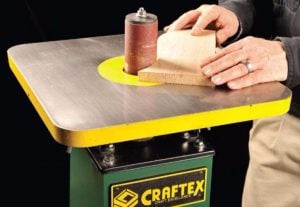[AdSense-A]You’ve probably already noticed that sanding curves and other unique angles and shapes are quite difficult with the sander you have in your tool shop, and for this you need something a bit more unique. Oscillating spindle sanders offer a sense of unique and creativity that really brings out the very best in woodworking. This type of sander is best suited for creativity, performance, and precision sanding that is nearly impossible to tackle using conventional, typical sanders.
Oscillating spindle sanders is sort of a dual purpose sander that is affixed, and protrudes from a base. Depending on the size, most are portable and can easily be moved from one location to another. This stationary sander comes equipped with a tabletop with a spindle which provides the sanding that protrudes upwards from the  center of the base.
center of the base.
An abrasive sleeve which is where the sanding action takes place is attached to a drum that oscillates in an up and down and circular motion. This fluid motion allows you to move the plane of the wood gently against the spindle which allows you to customize shapes, angles, and unique objects.
Below are some tips and tricks from the pros as well as some helpful information on how to use an oscillating spindle sander.
Safety is Always First
The first tip is safety as is the case with all power tools. There are many safety mechanisms that come standard in oscillating spindle sanders, but if used incorrectly and without the recommended safety equipment the inevitable can happen. Always done eyewear and ear protection as well as a respirator to minimize any airborne sanding dust. Also, be sure to remove any loose fitting clothing such as a baggy, long sleeve shirt as the shirt itself can be caught in the sanding mechanism.
Sand in a Fluid and Natural Motion
When sanding, use a fluid and natural motion. What I mean is very simple, you never want to force the wood into the spindle, but instead start off at the end of the plain, and with one fluid motion move the wood through the spindle itself. The oscillating motion will provide an even plain of sanding that will move through the wood, instead working against the wood.
Be sure to unplug the sander when changing out the sanding sleeves. Anytime you can be overcautious is something you should consider as it’s impossible to take back what’s already done. Simple things such as unplugging the power source when conducting maintenance, changing out the sleeve, or making fine adjustments are all worth considering.
For More, Check Out or In-Depth Guide on How to Use a Spindle Sander
Sand to the Line, and Not Over the Line
When using an OSS sander, you’ll want to mark your measurements with a pencil. This type of sander is manual and it’s precision is only good as the measurements and what you see with the naked eye. After making your mark, be sure to sand to the line instead of over the line. Typically, measurements are to the line, and sanding until it is completely gone can mean oversanding by as little as 1/16th of an inch. Oversanding by something so minimal may seem small, but if it’s 100% avoidable, then why not avoid it.
Use the Largest Spindle Representative of the Project itself
While this may be a foregone conclusion for many, but you’ll be surprised. When choosing what spindle to use, make sure you choose the largest one for the job itself. Spindles come in various sizes, and you may be spending hours too many if using one that is much smaller than what’s actually needed.
[AdSense-A]






I have a DeWalt oscillation spindle sander and can not keep the sanding sleeves to stay on the rubber drum when I sand. The sanding sleeves just starts to rise up off of the sleeve. How do I prevent this?